Onwards with the Spring shows! I’ve been really surprised at what’s been picked up and what’s been dropped – everything kind of seemed generic but most shows ended up being pretty fun, if not a bit overdone. The twists for some were enough, but others…
Renai Boukun fell under another “oh my god another harem” and then pretty much did away with most of the generic antics within 10 minutes… at breakneck speed. And then there was yanderes! And yuri! Incest yuri! And then uh… some deep shit about love. And a crazy girl. The description doesn’t really do it justice.
![[HorribleSubs] Renai Boukun - 02 [720p].mkv_snapshot_15.18_[2017.05.05_12.11.03]](https://weebtheory.wordpress.com/wp-content/uploads/2017/05/horriblesubs-renai-boukun-02-720p-mkv_snapshot_15-18_2017-05-05_12-11-03.jpg?w=1108)
And at least the OP is catchy.
![[HorribleSubs] Renai Boukun - 01 [720p].mkv_snapshot_01.08_[2017.05.05_12.06.05]](https://weebtheory.wordpress.com/wp-content/uploads/2017/05/horriblesubs-renai-boukun-01-720p-mkv_snapshot_01-08_2017-05-05_12-06-05.jpg?w=1108)
Renai Boukun OP Analysis
Koi? De Ai? De Boukun Desu! by Wake Up, Girls!
Key: G Mixolydian
PDF is here. Lyrics in wonderful gajin romaji! Thanks to Ran-chan~☆♪ for looking it over.
Form: Intro, A, B, A, B, Intro’, C, Coda
I definitely think this is one of the earworm OPs of the season – a combination of interesting but digestible harmonies, rapid and varied syncopation, and the upbeat feel all contribute to how well this sticks in your ear.
And tritones. SO many tritones. But as you’ll see, they’re the backbone of this piece.
I will admit this may seem pretty damn foreign to those not too familiar with their 7th chords and their circle of fifths. (ii V I progressions and all that.) I urge you to read up on it somewhere… anywhere? This is definitely a bit of a heftier subject that dips into more modern harmony stuff. But hey, that’s what we’re here for.
Intro
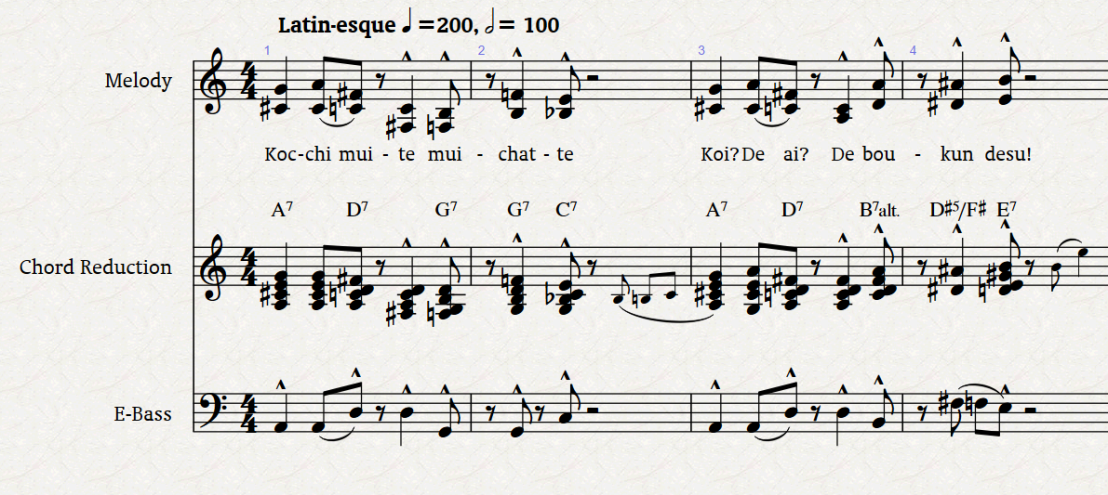
Within the first bars of the piece, we’re given a crash course primer in tritone harmony. Bear with me – it’s not as scary as it looks.
As you may already know, harmony revolves around resolution. The most common one we’re all familiar with is the V chord to the I which gives me the usual satisfaction of chord progressions. We’re just doing it… a LOT of times here. Working backwards from the C7 in m. 2, the V of that is G7! And the V of G7 is D7! And the V of D7 is A7. So when we put it together, we get a nice stack of resolving fifths. Now, the resolutions don’t stick out because all the chords are dominant chords, so it never feels like we’ve completely settled down in a key center [hence the reason there’s no key signature in the beginning].
Remember that dominant chords harbor a little nasty tritone that prevent them from feeling completely resolute, save for some functions in a more straightforward jazz setting [where tensions happen just for the sake of being tense]. In a pop-esque song like this, we’re kind of left wondering where we’re going next, since there’s no end to the stacks of dominants.
m. 3-4 do a similar thing, but resolve in a different manner, ending on E7. It’s slightly more forced and more out there than the sequence before. Ignore the D#5 chord for a moment, as it only serves as a leading tone – because we’re still in a harmonic quandary, going from D7 to B7(alt) is a-ok, thanks to chromatic mediants – they’re dominant chords that live a major/minor third away from another chord, and they’re considered equal in harmonic weight due to the symmetry of the major third. A chord with nothing but major thirds has ALL the notes equidistant from each other, so the concept is you can substitute that chord a third away easily. Coltrane uses this in the ill famed Giant Steps and links the entire sequence over keys all a major third away from each other. This can be its own post of info, since the working behind it are pretty fascinating to both the ear and the eye. But that’s another day.
Man, we haven’t even gotten past the first 10 seconds.
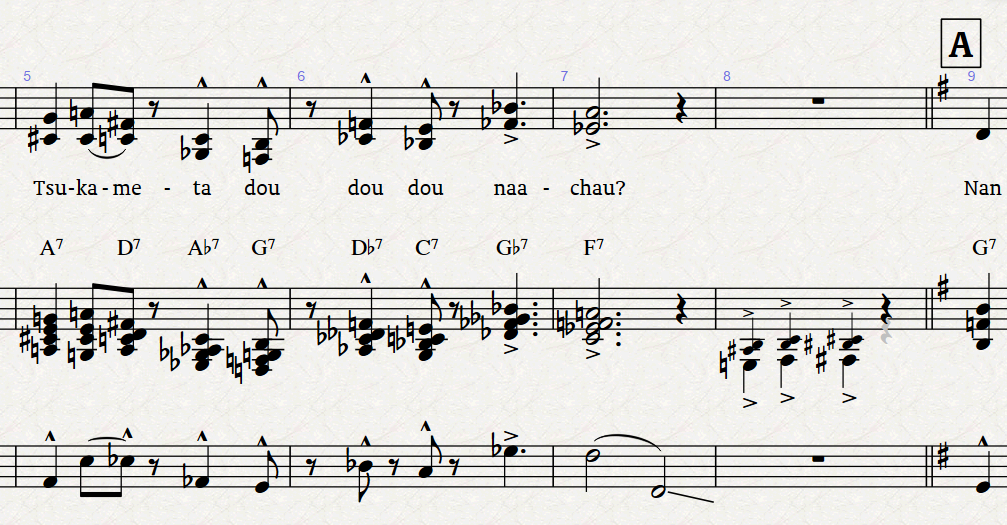
m. 5-8 takes ANOTHER method of going around the circle of fifths… This time through the magic of tritone substitution. As we said before, dominant chords must have some sort of a tritone within them… that’s where they get their unstable nature. Because of this, you can substitute a chord that’s a tritone away from the original chord and it’ll have the same function!
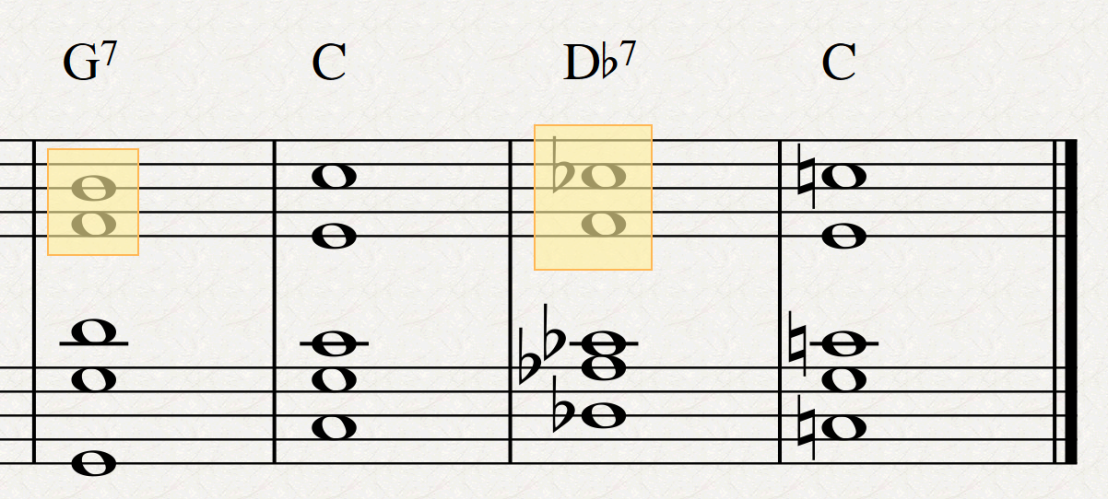
G7 and Db7 both use F and B/Cb (enharmonics!) in order to resolve to C. Because of this, you can freely exchange the 2 chords for the same harmonic effect [barring whatever melody notes exist – hold that thought!]. You can use this technique primarily to smooth out basslines or other voice leading woes (see how little the notes move from Db7 to C? Especially in the bass.)
So, looking back – if we’re trying to arrive at F7 in m.7, work backwards: Gb7 is the tritone sub for F’s V chord (C7). C7 and Gb7 have the same harmonic weight in this context, so switching between them is okay – Db acts as ANOTHER tritone sub V for C7. Db7 and G7 have the same harmonic weight, and Ab7 serves as the sub for G7, and so on until we get back to A7. Let’s remap that out:
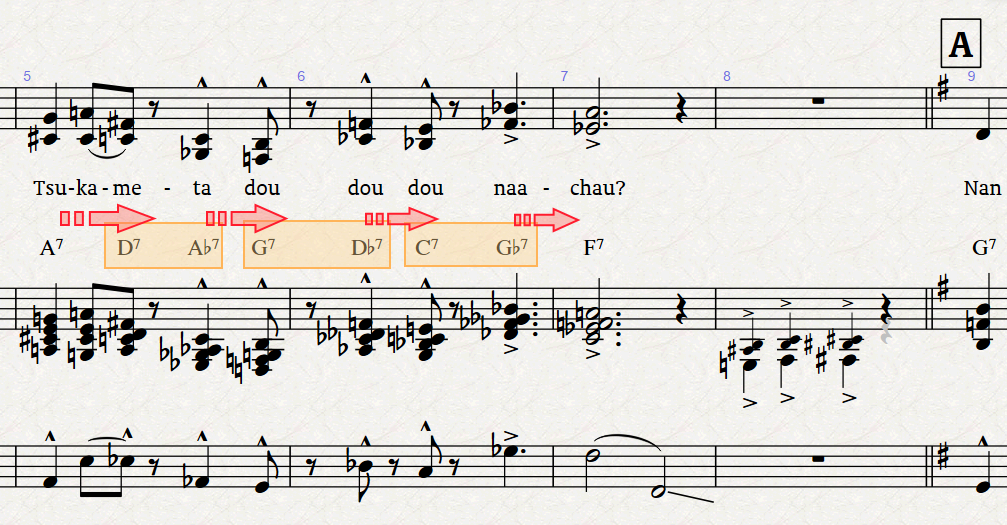
Let’s drive the point home further – the melody and harmony in the voices are almost all the tritones themselves. So, when the voices or guitar part play the written parts, we can be a ambiguous with the harmony as possible and still have the same effect! It’s very clever writing, but it’s definitely a challenge to keep parallel tritones together. [Thank god for pitch correction.]
As for the F7, it acts as our good old bVII for the G Mixolydian’s I chord, giving some sort of closure for the intro, and we jump right into the verse.
A – Verse

After all that harmonic hoo-hah, the verse itself is real simple in terms of harmony. We’re anchored on a G7 for most of it. Notable: The guitar part graciously outlines the tritone that exists in the chord, but because G7 is hammered in so much we’re not so inclined to believe it’s trying to resolve to something. It makes it sound kind of campy, to a degree. The F7 and F#7 are all just chromatic resolutions back to G7, so they look kind of odd out of context but in our cozy confines of G, it’s all good.

Common practices with pop songs- both Western and Eastern- is to have rhythmic motives that are easily noticeable within the song. A lot of a song’s identity can rely not just on the melodic contour, but on the rhythmic one as well. The rhythmic motive I’ve highlighted in blue is gonna pop up about like… a million more times in the song. One can also pick out the smaller motives, but this one is a bit more prominent over the rest. Man, you could even argue that a quarter note is a motive, but that’s now beyond the realm of usefulness – you want something that is identifiable as part of a specific song, anyhow.
B Section
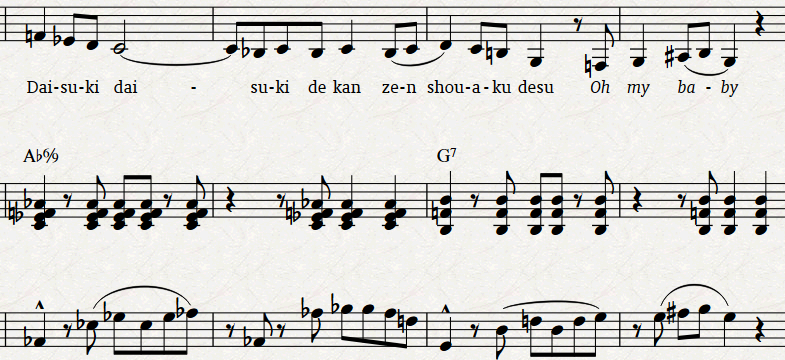
The chords alternate between Ab6/9 and G7 here. Ab6/9 doesn’t have the 7th, so it can’t claim to be a tritone substitution (there’s no Gb) – but it can claim to be a borrowed chord from the G phrygian mode. And that’s enough for it to feel like a plagal cadence in my book. It certainly doesn’t feel as strong a pull as what we experienced earlier. Some people might consider an F or Bb chord just anchored over an Ab and that may work as well.
A+B, Second Verses
Very identical to the first verse, harmonically and melodically – save for this:

Crossed Notes (m. 27) are ghosted – This means a note is glossed over or barely played to the point of almost not being there. It’s partially subliminal, but as you’ll see some syllables in the Japanese language (Cha-ku Cha-ku) will naturally form like that. YOu can kind of hear a semblance of pitch with the notes, but it’s not enough to be considered a full note at all. Kind of sucks for them, in a way – but it emphasizes the other syllables in contrast.
It’s worth noting the top harmonies are significantly softer than the lower ones – this is deliberate so the melody doesn’t lose the spotlight. A lot of folks will tell someone to not write harmonies above a melodic line, but volume plays a large role here in making sure it’s not overpowering – even though it’s considerably brighter.
Intro Reprise/Pre-chorus
The reprise until m. 47 is hit-for-hit like the beginning, save for the lack of a lower harmony in the voice. It’s still covered in the guitar part, though.
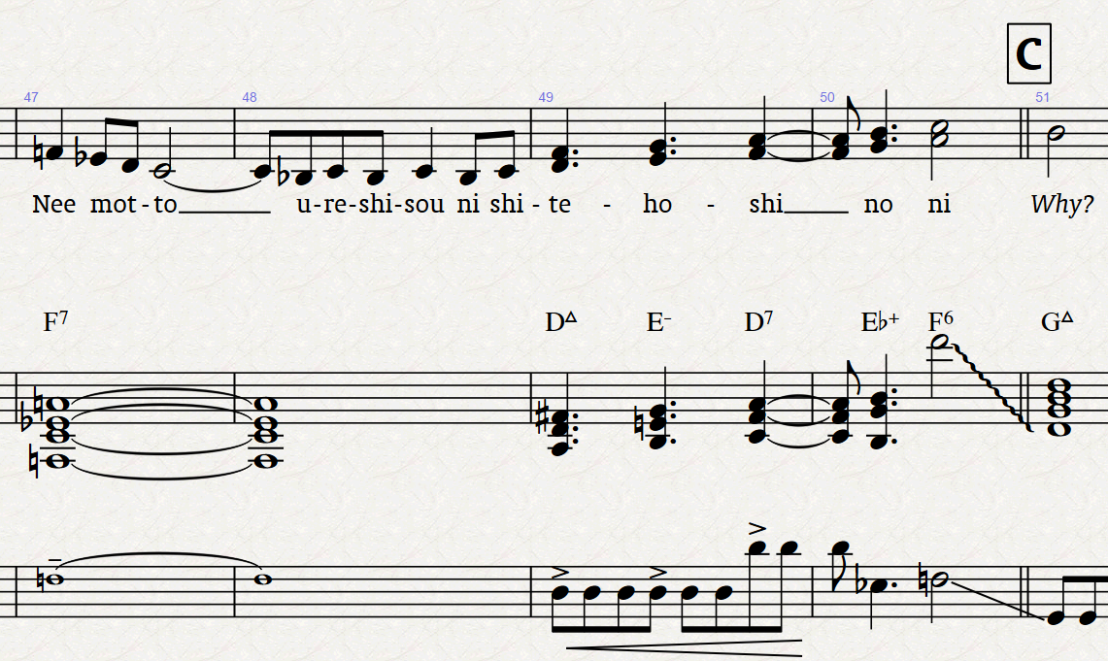
The F7 into D (can be implied to be a D7 since it’s scalar motion) is another forced chromatic mediant at work. Something of note is the Eb augmented chord – The progression itself is bVI -> bVII -> I which is a common cadence style in mixolydian, but having the bVI be augmented is interesting. Realistically, it adds the extra tension that is missing from the lack of a true V chord, by really maxing out the spacing between notes (all major thirds in-between) and then closing the gap on the F6 (arguably could be a D7#9, but the bass note+lack of other notes implies otherwise… might not be a bad idea, though.)
Chorus
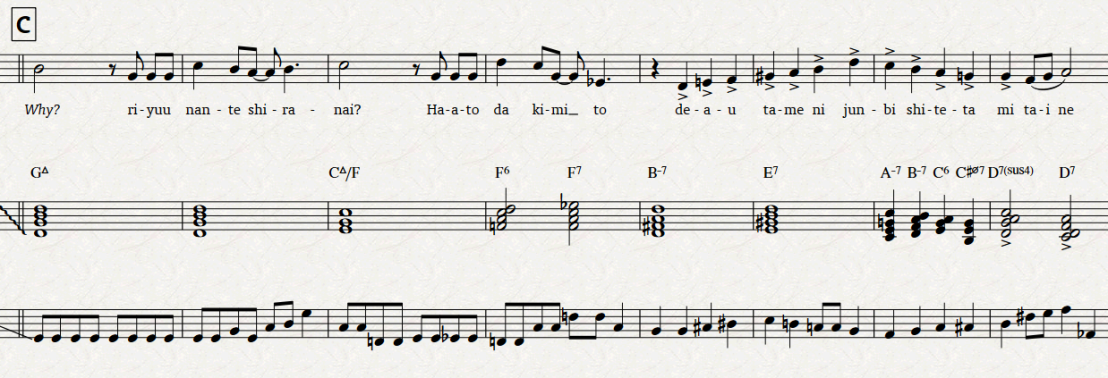
There’s a few ambiguous chords in here that make this no so straight forward. Starting on a solid I chord into an IV chord… with bVII as the bass. Why is it C/F instead of, say, Fmaj9? Voicings. There’s no A to support the fact this could just be an extended F chord, rather than a C chord, and the C in the melody reinforces the fact, and gets a bonus harmonic jump coming from G (which, going by the circle of fifths, blindly wants to go to C)! We establish the F chord with a shifting extension in the following measure (D, followed by Eb, F6 to F7). Then comes some trickery…
GO to the end of the phrase where D7 resides and work backwards- C#halfdim is just a neutered A9 (It’s got all the notes of A9, including the functioning tritone) so we can treat it as a more sterile V chord. The C6 is a passing chord to help smooth out the transition between Bm7 and C#halfdim. Before that, the A minor is a diatonic chord that exists in G mixolydian already, and gets its V chords from the E7 before, which gets its relative “ii” from the Bm7 chord before it. Another roadmap:
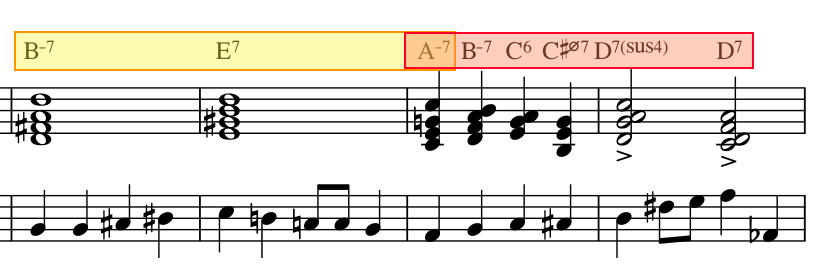
If you look at the chords both progressions end on, It’s a glorified way to end on an Am7 (the ii chord of G) and a D7 (the V of G major) – keep in mind, we’ve been in mixolydian this entire time, so this D7 is kind of a big deal, since it reintroduced the missing leading tone we’ve been going without this whole time – this particular cadence really feels strong in comparison to everything we’ve heard up to this point. It’s still a little softened by the sus4, though…
As for the tail end:

I -> I -> IVadd9 -> V/V (vii/V)-> I6/4 V/VI -> VI(?) -> IV -> I6/4 V ->…
In essence, it’s similar to the progression from before in terms of where it’s going (Big V chord at the end!) and anchors a true IV chord in the process instead of an unsteady C/F.
The post-chorus is a bit of an oddity.
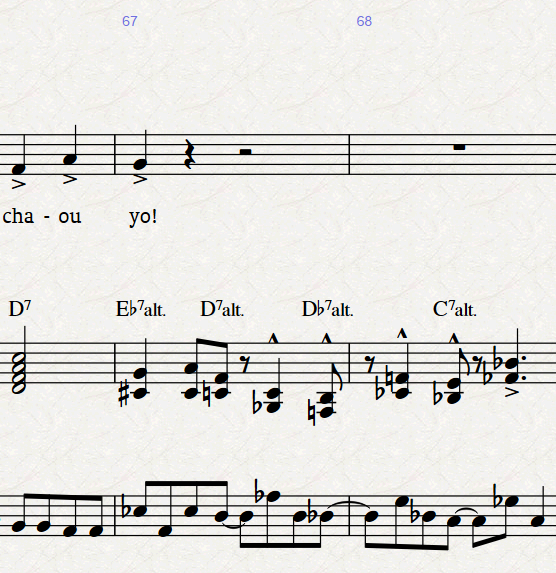
What are these alt chords? From a glance, the D7 to an Eb sort of makes sense as a V->bVI deceptive cadence. (We’re okay with this because the melody still ends on a G – the tonic, so it’s less jarring than we believe). Notice how the chord reduction still have the notes from the beginning of the piece. They’re still A7 -> D7 -> G7 -> C7… but it’s a different type of tritone substitution. The bass simply plays a tritone away from the original tonic of the note – So in essence, you’re still getting the function as listed above, AND also smoothing out the bassline. These alt chords are essentially that- an alternative to the notes that are listed – but that’s another post for another day.
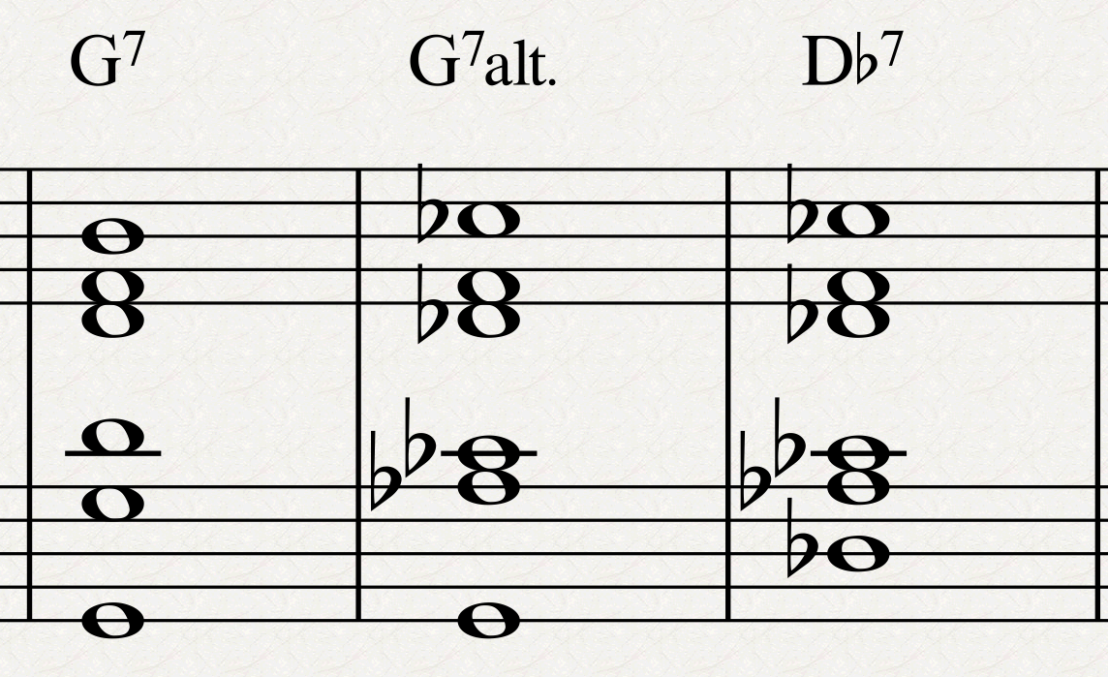
It is considerably crunchier and more nebulous than the original chord – which is the point, this is kind of like a falling down point where the song can lead anywhere – but it is an incredibly cool trick. It has a lot more harmonic pull, too – the addition of an Ab->G and a Db->C (assuming we’re going to C) is powerful and definitely something I’ll look into future posts. For now, this’ll do.
Coda
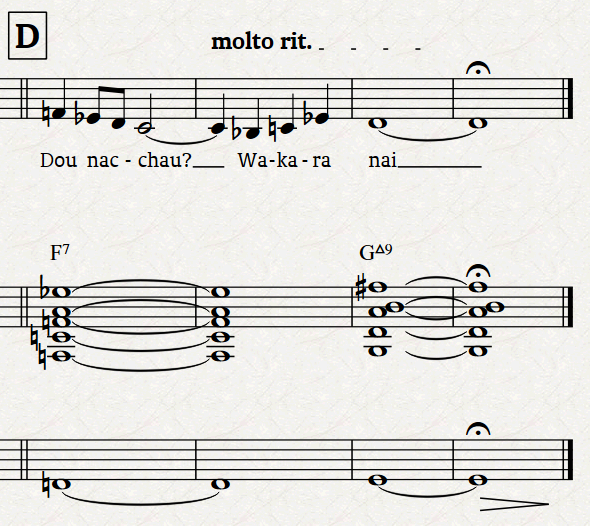
Kind of cool how it takes the pre-chorus F chord and melody and uses it to gently cadence us onto a rather fluffy sounding Gmaj9. Considering it’s the last chord, it should sound like it has a sense of being finished, with the added bonus of Gmaj9 not existing in the original mixolydian mode – so it’s definitely an ending point for this tune.
![[HorribleSubs] Renai Boukun - 02 [720p].mkv_snapshot_13.54_[2017.05.05_12.10.30]](https://weebtheory.wordpress.com/wp-content/uploads/2017/05/horriblesubs-renai-boukun-02-720p-mkv_snapshot_13-54_2017-05-05_12-10-30.jpg?w=1108)
jazz modern harmonies is great! It’s nothing new by any means, but knowing that the tools are being used more frequently will really lend to some crazier stuff down the line. I’m waiting for my prog synth Snarky Puppy inspired anime OPs in 2020. Provided someone hasn’t mass-manufactured real life killer yanderes by the time the Olympics rolls around.
A final word and disclaimer: I am not the end-all-be-all of theory. Many of these transcriptions are done by my ear, and perhaps maybe I’ve missed a note or two. Let me know.
~Angular
